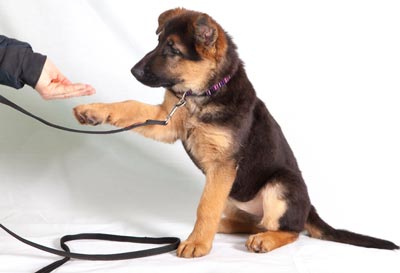
01 May Puppy Training 101
Tips for House Training Your New Puppy (An Easy How-To Guide)
Are you ready to start Puppy Training? Appropriate training and socialization are among your puppy’s basic needs. It is critical to begin training your dog as early as possible.
At first, training your puppy can seem a bit frustrating, particularly if this is your first pooch. The truth is that puppy training is a huge project. If you exercise it step by step, you will find the task to be far less daunting.
When to Begin House Training Puppy
Specialists suggest that you start house training your puppy when they are between 12 and 16 weeks of age. At that age, they can control their bladder and bowel movements to learn to hold them.
If your pooch is older than 12 weeks when you bring them home, house training can take longer. You will have to improve the dog’s behavior— with praise and reward.
The Best Way to Train a Puppy
Puppies as young as 8 weeks of age have the capability to learn the fundamentals, but keep in mind: The younger the puppy, the smaller the attention span. Puppy training lessons must be short, enjoyable, and enriched with many play opportunities.
The effective method to train a puppy is to perform exercises when they are well-rested. Ensure they are ready to go but not over-excited, as it can be harder for them to focus. Before you start, take your pooch outside for a potty trip, and ensure to take them out right after you finish as well.
You’ll require a pocket filled with great puppy treats. Puppy training needs plenty of rewards, so pick something like Wellness Soft Puppy Bites, which are small but also delicious enough to maintain your puppy interested in the training game.
Basic puppy training should take place in a distraction-free, familiar environment. You and your dog will eventually move to working outside and in new areas, but the training first stages must be occurring in a subtle area to ensure that it’s easy for your dog to focus on you.
It’s also useful to have several puppy toys available to go so you and your pooch can take play breaks. A tug toy, like a ball for fetching, or the Charming Pet Magic Mats Unicorn plush dog toy are excellent choices that enable your canine to burn through some puppy excitement before it’s time to focus again.
Puppy Training: Basic Commands
The first phase of training includes basic commands since it is a foundation for every other type of training. Basic commands such as “come,” “sit,” “stay,” “lay down,” and “leave it” are essential behaviors to keep your dog happy and safe as he explores the world.
How to train your puppy to come when called
To train your puppy to come back to you, you should learn to be more interesting than the rest of the world!
This is an essential command to train your dog because it helps to keep him secure and implies he can benefit and enjoy from an exercise off the lead.
- It would help if you had a reward to motivate your puppy to come back – an enjoyable game with a toy or a yummy treat. Show your puppy the food or toy.
- Take a couple of paces, then call your pooch’s name and claim “come” in an exciting, friendly tone – getting down low may also encourage him to come back to you.
- As your puppy comes to you, gently hold his collar and let him have fun with the toy or feed him the reward.
- Slowly increase the distance you are from your puppy until you can finally call your dog from room to room.
- Ask a friend to gently hold your puppy’s collar whilst you walk a distance away and then call him to come to you.(Don’t forget the reward!)
- Once your puppy is regularly coming to you when called, you can start to exercise in a safe outside environment. Lengthy training leads can be useful for exercising recall when outside as they permit your puppy some liberty without giving them total free-range at this phase.
How to train a dog to sit
Training your puppy to sit is an excellent command, to begin with, your training. It can be a beneficial behavior for him to learn.
For instance, teaching your pooch to sit when the doorbell rings mean he is less likely to jump up on visitors when the door opens, and asking your dog to sit at curbs can make crossing roads safer.
- With your puppy in a standing situation, keep a delicious treat near his nose.
- Holding the treat near your pooch’s nose, move your hand in an arc over his head. As the dog raises his head to follow the treat, his bottom will go on the floor. The moment he sits, reward him, and give him praise.
- Practice this several times in short but regular sessions.
- As the pet constantly gets a reward for sitting, you’ll soon see, he sits for longer. You can now add the command “sit” as he goes to sit. Be careful not to claim it before your puppy moves into position, or he might connect it with the incorrect movement.
- Practice this several times in short but regular sessions.
Find more tips and the complete article at https://www.thegreatpets.com/puppy-training/



Sorry, the comment form is closed at this time.